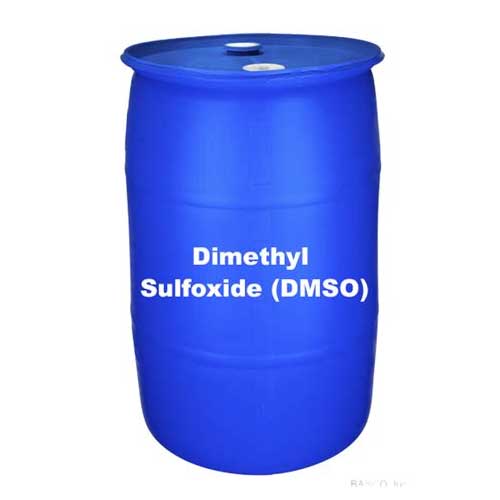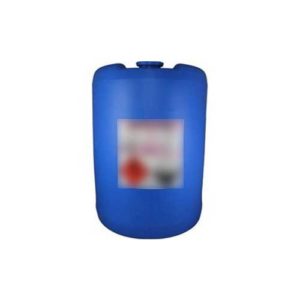DIMETHYL SULFOXIDE (DMSO) – C2H6OS
ABOUT:
Dimethyl sulfoxide (DMSO) is created by reacting dimethyl sulfide with oxygen. The reaction is typically carried out in the presence of a catalyst, such as copper or silver, in a reactor.
PHYSICAL PROPERTIES:
Appearance: clear, colorless liquid
Odor: odorless
Taste: distinctive, slightly sweet taste
Molecular weight: 78.13 g/mol
Boiling point: 189.3 °C (372.7 °F)
Melting point: 18.5 °C (65.3 °F)
Density: 1.1 g/cm³ (at 20 °C)
Refractive index: 1.47
Viscosity: 1.9 cP (at 20 °C)
CHEMICAL PROPERTIES:
- DMSO is an excellent solvent, dissolving both polar and nonpolar substances, making it a popular choice in chemical and biological research.
- DMSO has a high dipole moment due to the polar sulfoxide functional group, which makes it highly polar and capable of dissolving polar and ionic compounds.
- DMSO has the ability to participate in hydrogen bonding, which makes it a highly effective solvent for polar compounds.
- DMSO is chemically stable and does not react with most substances, making it a suitable solvent for a wide range of compounds.
- DMSO is relatively non-toxic, with a low acute toxicity in animals and low skin irritation potential in humans.
- DMSO acts as a proton donor in acidic solutions, which makes it useful in various chemical reactions.
- DMSO is a highly reactive molecule, and it can react with electrophilic reagents to form new products.
APPLICATIONS:
AGROCHEMICAL INDUSTRY:
- DMSO can be used as a carrier for pesticides and herbicides, allowing for more effective and efficient delivery of these substances to crops.
- DMSO has been shown to have fungicidal properties, making it effective against a variety of fungal pathogens. Its mechanism of action involves inhibition of fungal growth and spore germination.
CLEANING APPLICATIONS:
- Oils, greases, and other organic contaminants can be removed with DMSO from a variety of surfaces, including metals, plastics, and ceramics. As a result, it can be used as a cleaning agent in a variety of industries, including automotive, electronics, and manufacturing.
- Sticky residues, such as adhesives, can be effectively removed from a variety of surfaces, including glass, plastics, and metals, using DMSO.
- DMSO can also be used as a paint stripper, removing coatings from metal surfaces in particular. Because of its ability to dissolve a wide range of coatings, it is a viable alternative to the more toxic and caustic chemicals commonly used for paint removal.
COATINGS INDUSTRY:
- DMSO is a highly polar solvent that can dissolve a wide range of organic and inorganic substances, making it useful as a diluent for coatings and inks.
- DMSO can improve the adhesion of coatings to various substrates, including metal, glass, and plastic, by penetrating into the surface and forming chemical bonds.
- DMSO can be added to coatings to improve their drying time, as it has a low evaporation rate and can help distribute the coating evenly.
ELECTRONICS INDUSTRY:
- DMSO is a highly polar solvent that can dissolve a wide range of organic and inorganic substances, making it useful for cleaning and removing contaminants from electronic components and surfaces.
- DMSO has high thermal conductivity and can be used as a cooling medium in electronic devices, particularly in high-power applications where conventional cooling methods may be inadequate.
PHARMACEUTICAL INDUSTRY:
- DMSO is a highly polar solvent capable of dissolving a wide range of organic and inorganic substances, making it useful for drug preparation and dissolution, as well as extracting active ingredients from natural sources.
- DMSO has anti-inflammatory and analgesic properties and has been used as a topical pain reliever, particularly for conditions like osteoarthritis.
POLYMER PROCESSING:
- Dimethyl sulfoxide is a highly polar organic solvent with a variety of applications in polymer processing. Because it can dissolve a wide range of polymers and improve the processing of thermoplastics, thermosets, and elastomers, it is frequently used as a co-solvent or plasticizer.
- DMSO is used to make polymer solutions, which can be used in a variety of applications such as coating, laminating, and moulding. The polymer solution is applied to a substrate and then subjected to heat or pressure to solidify and form a polymer layer in these processes.
TEXTILE INDUSTRY:
- DMSO is used as a cleaning agent for removing grease, oil, and other impurities from textile fibers, it is also used as a softening agent to make fibers more pliable.
PULP AND PAPER INDUSTRY:
- DMSO is used as a dispersant to improve the wetting and penetration of chemicals used in pulp processing and as a cleaning agent for paper-making machinery.
SAFETY MEASURES:
- When handling DMSO, it is important to wear protective clothing, such as gloves, goggles, and a lab coat to prevent skin contact and eye exposure.
- DMSO has a strong odor, so it is important to work in a well-ventilated area to minimize inhalation exposure.
- DMSO should be stored in a cool, dry place, away from heat sources and flammable materials.
- DMSO is toxic in high concentrations, so it is important to follow the recommended concentrations and dilutions when using it as a solvent or in other applications.
- If DMSO comes into contact with skin, it should be immediately flushed with water for at least 15 minutes. If a significant amount of DMSO has been ingested, seek medical attention immediately.
- In case of eye exposure, flush the eyes with water for at least 15 minutes and seek medical attention if necessary.
- DMSO should be disposed of properly, following the regulations and guidelines set by your local waste management authorities.






Reviews
There are no reviews yet.